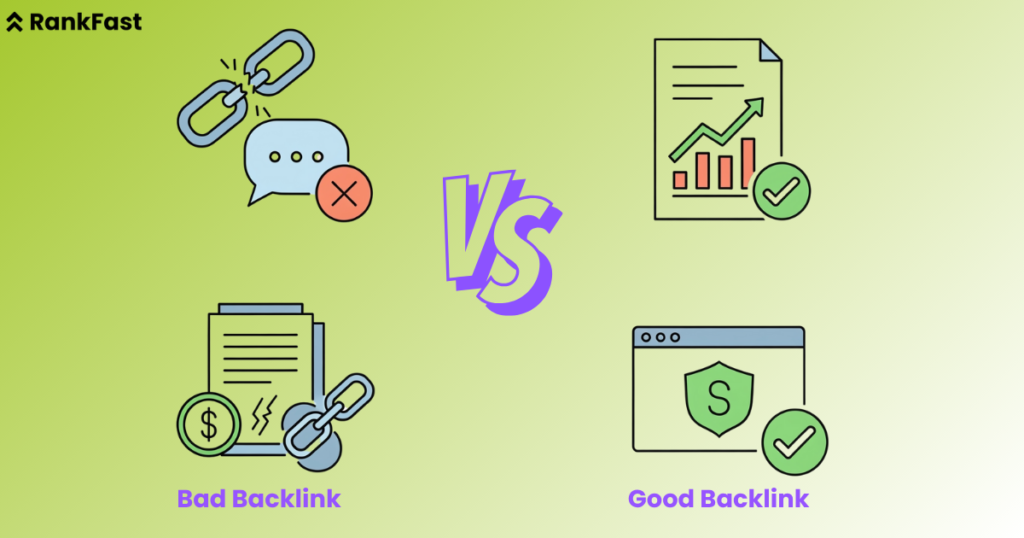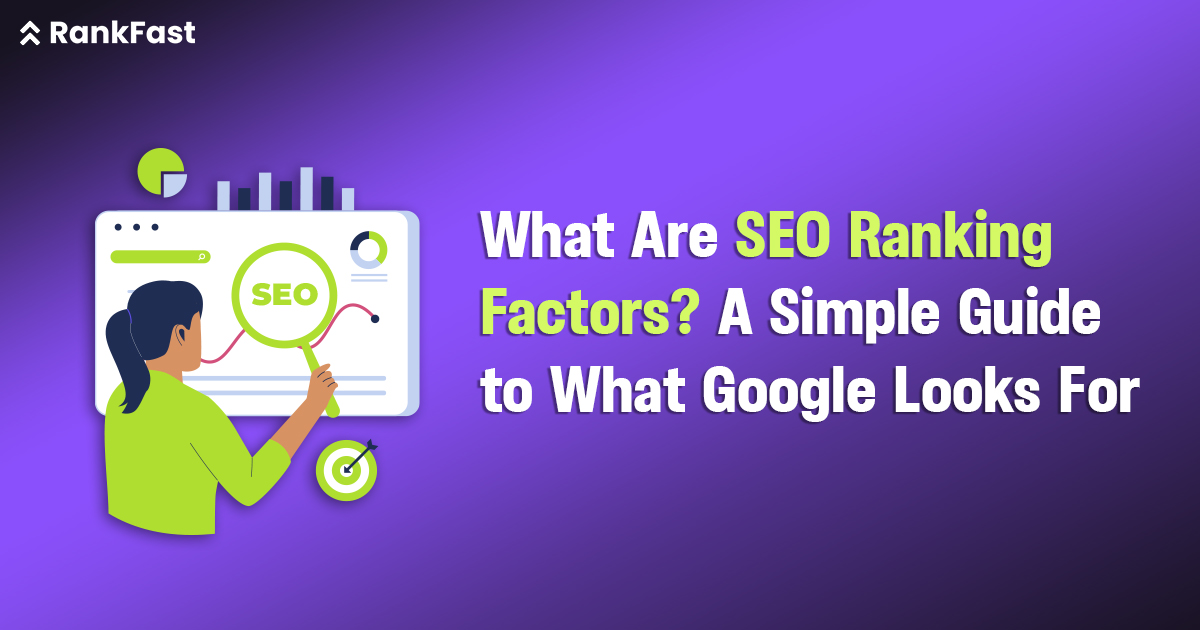Why do some websites never move up in Google even after months of content updates? Because most site owners still miss what matters. They keep chasing random tips, stuffing keywords, or buying poor backlinks.
Google clearly states: PageRank (links) and content quality are core ranking signals. If your strategy skips those, you lose visibility. In this blog, we break down the SEO ranking factors that actually matter and how to fix what holds your site back.
What Are SEO Ranking Factors?
SEO ranking factors are signals Google uses to decide where a webpage should appear in search results. These signals include content, links, speed, structure, mobile design, and more.
When someone searches “best digital camera under 50k,” Google checks your page to see if it answers the question clearly, loads fast, looks clean on mobile, and links to/from relevant sources. If yes, you’re closer to page one. If not, you get buried.
Google ranking factors help Google judge three things:
- Is the page trustworthy?
- Is the page helpful and readable?
- Is the page a good match for the user’s question?
These factors keep changing, but the fundamentals remain steady. Good content, natural backlinks, fast pages, and easy navigation win most times.
Understanding how Google ranks websites is not about gaming the system. It’s about building pages that deserve to rank. Next, let’s break down each factor clearly.
Core SEO Ranking Factors Google Looks For
Google looks at over 200 signals. But not all are equal. Some signals carry more weight than others. Here’s a breakdown of important SEO factors using clear points:
| Factor | Weight in SEO | Area | Action Needed |
| Content Quality | Very High | On-page | Write clear, helpful, detailed content |
| Backlinks | Very High | Off-page | Build natural, trusted links |
| Mobile-Friendliness | High | On-page + Technical | Use responsive design |
| Page Speed | High | Technical | Improve loading time |
| UX Signals | Medium | Behavioural | Improve layout, reduce bounce |
| Internal Linking | Medium | On-page | Use topic-based internal links |
| Schema Markup | Medium | Technical | Add structured data |
| HTTPS Security | Medium | Technical | Use an SSL certificate |
| Freshness of Content | Low to Medium | On-page | Update blogs regularly |
| Domain Age/History | Low | Off-page | Maintain a clean domain record |
These factors, when aligned, push rankings consistently. Let’s look deeper into each one now.
1. Content Quality
Google wants to show useful content. That means your content must match what users want, be clear, updated, and written with authority. This is the most important among all Google ranking factors.
What helps:
- Use headings properly (H1, H2, H3)
- Answer questions clearly
- Add examples, stats, and FAQs
- Cover related terms (not just keywords)
For example, a blog on “What is SEO ranking factors” must include backlinks, content, technical signals, and user experience, not just keyword definitions.
Google uses AI models like BERT and MUM to understand if your content is helpful. So, stuffing words without meaning will hurt more now.
Use content frameworks like:
- AIDA (Attention-Interest-Desire-Action)
- PAS (Problem-Agitate-Solution)
These models improve structure and depth.
2. Backlinks
Backlinks remain the strongest off-page SEO signal. But not all links help. Google values:
- Contextual links
- Links from relevant, high-authority websites
- Editorially given (not bought or exchanged)

Avoid:
- Spammy directories
- Blog comment links
- Link farms or paid links
Use tools like Ahrefs or SEMrush to check your link profile. Remove the toxic ones.
A clean backlink strategy:
- Publish guest posts on good sites
- Get listed on niche directories
- Create research-based content that others reference
Backlinks pass trust and domain authority. Without them, even good content struggles.
3. User Experience (UX) Signals
UX is not only about design. It includes how users behave on your page. Google measures:
- Bounce rate
- Time on site
- Pages per session
- Scroll depth
If visitors click and leave fast, Google reduces your rankings.
To fix this:
- Use short paragraphs
- Add bullet points, images, and headings
- Match user intent
- Improve internal linking
Good UX makes users stay longer. That tells Google your page helped them.
4. Mobile-Friendliness
Most searches now happen on mobile. If your site doesn’t load well on phones, you lose both rankings and users.
Google uses mobile-first indexing. That means Google sees your mobile version first, not desktop.
Check these:
- Is the text readable on phones?
- Are buttons easy to tap?
- Does the layout adjust to screen size?
Use Google’s Mobile-Friendly Test tool. Fix broken layouts with responsive design. Use flexible grids and media queries.
5. Page Speed
Slow pages kill rankings. Google confirmed that speed affects search rank and user bounce. Even a 1-second delay cuts conversions.
To improve speed:
- Use fast hosting
- Compress images (WebP format)
- Minify CSS, JS files
- Use lazy loading for images
- Enable browser caching
Measure with:
- Google PageSpeed Insights
- GTmetrix
Speed also impacts Core Web Vitals, a set of user-focused performance metrics. These include LCP (Largest Contentful Paint), FID (First Input Delay), and CLS (Cumulative Layout Shift).
6. Technical SEO
This is the backend structure of your site. It helps Google crawl, index, and rank your pages.
Checklist:
- Use a clear sitemap
- Fix broken links
- Remove duplicate content
- Use canonical tags
- Optimize robots.txt file
- Add schema markup
Structured data helps Google understand your content. For example, using the FAQ schema lets your answers appear directly in search results.
Also, switch to HTTPS. Google gives preference to secure sites.
7. On-Page Optimization
On-page and off-page SEO work together. But on-page is where you have full control.
Key areas:
- Title tags with keywords
- Meta descriptions that encourage clicks
- Proper URL structure (short and keyword-rich)
- Image alt text
- Keyword in the first 100 words
- Proper H1 and H2 use
Avoid repeating keywords. Use variations. For example, instead of repeating “Google ranking factors,” use “how Google ranks websites” or “important SEO signals.”
8. Internal Linking
Internal links help distribute authority. They guide Google and users to related content. This supports topic relevance.
Tips:
- Link related blog posts together
- Use keyword-rich anchor text
- Keep the structure logical (from top pages to new posts)
- Fix broken links regularly
Example: If you have a blog on “SEO ranking factors,” link it to your guides on “on-page SEO” or “technical SEO.”
This improves crawl depth and reduces bounce.
9. Search Intent & RankBrain
Search intent means what the user really wants. RankBrain is Google’s AI system that matches pages to user intent.
Types of intent:
- Informational (know something)
- Navigational (go somewhere)
- Transactional (buy something)
A blog about “best laptops under 50k” should list options, not just explain specs. That matches intent.
RankBrain uses click data, bounce rate, and content structure to judge intent match. If you meet intent, you win.
What’s NOT a Direct Ranking Factor (But Still Matters)
Some things don’t impact rankings directly but still affect SEO performance.
These include:
- Social shares
- Domain age (Google said this is minor)
- Keyword meta tags (not used anymore)
- Bounce rate (indirect)
- Time on site (indirect)
These help user behavior but don’t influence search ranks directly.
Leaked/Speculated Signals (2024 Google Docs Leak)
In 2024, internal docs suggested some hidden signals. These are not confirmed, but are worth watching:
- Clicks from Chrome (user behavior tracking)
- Author authority signals
- Brand mentions (not just links)
- Site embeddings (based on context)
If true, it means SEO in 2025 may rely more on real user actions and less on plain links or words.
Best Practices to Optimize for Top Ranking Factors
Follow these tips for long-term results:
- Write topic-rich, not keyword-stuffed content
- Build links with intent, not shortcuts
- Use a schema to help bots understand
- Test speed monthly
- Match every blog with clear user intent
- Fix technical errors fast
- Interlink deeply across topics
- Use heading structure properly
Regularly audit your site. Tools like Screaming Frog and Ahrefs help find gaps in your structure.
Also, never copy. Google filters out duplicate or rewritten content that adds no value.
Final Thoughts
SEO success depends on knowing what matters and doing it well. Google ranking factors are not a secret. They’re clear if you track the right signals. Content and links still matter the most. But now, structure, intent, and speed matter too.
At Rankfast, we help businesses grow with strategy-backed SEO that delivers. Want to rank better? Start with us.
FAQs
1. Are keywords still important for SEO?
Yes, but Google now focuses more on context and topic relevance than exact keywords.
2. How often does Google update its ranking algorithm?
Google makes small changes daily. Bigger core updates come every few months.
3. Can I rank without backlinks?
Possible for low-competition keywords. But backlinks help build authority.
4. Do pop-ups hurt SEO?
Yes, especially if they block content. Use non-intrusive designs.
5. What are Core Web Vitals in SEO?
They are performance metrics that check speed, interaction, and layout shift of your site.

Leave a Reply